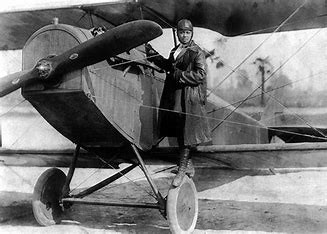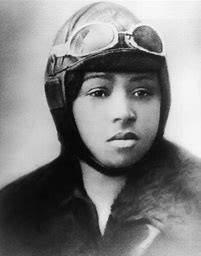On June 15, 1921, Bessie Coleman etched her name in history as she soared above the prejudices of her time, becoming not only the first African American woman but also the first woman with Native American ancestry to earn a pilot’s license.
The seeds of Coleman’s aviation journey were planted by her brother John, himself a veteran of World War I. He shared tales of French women aviators, inadvertently challenging Coleman’s resolve by remarking on the lack of opportunities for Black women in the United States. Instead of succumbing to discouragement, Coleman seized upon this challenge as a catalyst for her ambitions.
Undeterred by the closed doors of American flight schools, which shut her out due to the intersection of her race and gender, Coleman embarked on a relentless pursuit of her dream. Rebuff after rebuff only fueled her determination. It was then that she turned to Robert S. Abbott, the influential figure behind The Chicago Defender, a beacon of empowerment within the Black community.
Recognizing Coleman’s unwavering spirit and the potential for a groundbreaking narrative, Abbott lent his support, urging her to look beyond the confines of her homeland. He encouraged her to seek admission to a flight school in France, where attitudes towards race and gender might be more progressive.
In embracing Abbott’s counsel, Coleman ventured across the Atlantic, navigating not only the physical distance but also the vast chasm of prejudice that barred her from the skies in her own country. France, with its comparatively open-minded aviation institutions, provided the fertile ground for Coleman to cultivate her dreams.
Her journey was one of defiance against the status quo, a testament to the power of resilience and determination in the face of adversity. By earning her pilot’s license amidst the headwinds of discrimination, Coleman not only shattered barriers but also paved the way for generations of aspiring aviators, regardless of their race or gender, to reach for the skies.

In her quest to conquer the skies, Bessie Coleman embarked on a journey of determination and perseverance, overcoming obstacles with unwavering resolve. Armed with ambition and a thirst for knowledge, she delved into the intricacies of the French language, knowing that her aspirations hinged on her ability to communicate with aviation institutions abroad. Night after night, she diligently attended French classes, laying the groundwork for her eventual triumph.
Her persistence bore fruit when she secured admission to the prestigious Caudron Brothers’ School of Aviation in Le Crotoy, France, marking a significant milestone in her odyssey. It was within the hallowed halls of this institution that Coleman’s passion for flight found its wings, culminating in the attainment of her international pilot’s license on June 15, 1921, under the auspices of the Fédération Aéronautique Internationale.
Returning to the United States with her newfound credentials, Coleman harbored grand aspirations that transcended personal achievement. Her vision extended beyond mere flight; she yearned to own her own aircraft and establish a flight school, envisioning a future where others could follow in her footsteps.
Fueling her dreams with determination and ingenuity, Coleman embarked on a tireless campaign, crisscrossing the nation to share her aerial exploits with audiences far and wide. From churches to theaters to schools, she captivated audiences with her daring feats, refusing to lend her voice to venues tainted by the stain of segregation and discrimination.
In 1922, Coleman etched her name in the annals of history once more, performing the first public flight by an African American woman—a momentous occasion that further solidified her status as a trailblazer. Renowned for her aerial acrobatics, including daring “loop-the-loops” and graceful formations resembling the figure-eight, she mesmerized audiences on both sides of the Atlantic, ascending to newfound heights of fame and acclaim.
Yet, even as she basked in the adulation of crowds, Coleman remained steadfast in her commitment to uplift her community. She embarked on nationwide tours, imparting her knowledge through flight lessons and inspiring others, particularly African Americans and women, to defy the odds and pursue their own dreams of flight.
However, the trajectory of Coleman’s journey was not without its trials. In a sobering reminder of the risks inherent in her chosen profession, she faced her first major airplane accident just two years into her career. In February 1923, disaster struck as her aircraft’s engine faltered mid-flight, hurtling her towards the earth below. The crash left her battered and bruised, with a broken leg, cracked ribs, and lacerations marring her once unyielding spirit.
Yet, true to her indomitable nature, Coleman emerged from the wreckage with a renewed sense of purpose, her resilience undimmed by the trials she had endured. With unwavering resolve, she pressed forward, embodying the spirit of perseverance that defined her remarkable journey through the boundless skies.

Despite the harrowing ordeal she endured, Bessie Coleman’s passion for flight remained unyielding. In 1925, she courageously returned to the skies, resuming her daring aerial performances with a fervor undimmed by adversity. Through her relentless dedication, she amassed the funds needed to realize her dream of aircraft ownership, acquiring a Jenny – JN-4 with an OX-5 engine—a tangible symbol of her perseverance and determination.
Her triumphant return to her hometown of Texas, however, was marred by the specter of segregation. Confronted with the indignity of separate entrances for African Americans and white attendees, Coleman steadfastly refused to compromise her principles. In a bold stand against discrimination, she demanded unity, insisting that there be only one entrance for all spectators. Though concessions were made regarding seating arrangements, her unwavering stance resonated far beyond the confines of the stadium, cementing her reputation as a beacon of courage and integrity.
Tragically, on April 30, 1926, fate dealt a cruel blow as Coleman embarked on what would be her final flight. Accompanied by mechanic William Wills, the ill-fated journey took a catastrophic turn when a loose wrench became lodged in the aircraft’s engine, robbing them of control. As the plane plummeted from the sky, Coleman, unsecured by a seatbelt, was ejected from the open cockpit, her life cut short in a devastating moment of airborne tragedy. Wills, too, perished in the crash, leaving behind a somber legacy of loss and grief.
The news of Coleman’s untimely demise reverberated around the globe, leaving an indelible mark on the hearts of thousands who had been touched by her courage and resilience. In a poignant tribute to her memory, renowned activist Ida B. Wells-Barnett delivered a heartfelt eulogy at her funeral in Chicago, honoring Coleman’s pioneering spirit and unwavering commitment to equality.
Though her time on this earth was tragically brief, Coleman’s legacy endures as a testament to the power of perseverance and the indomitable human spirit. In the years following her passing, numerous aviation organizations emerged in her honor, ensuring that her name would be forever etched in the annals of history. From the establishment of the Bessie Coleman Aero Club by William Powell in the 1930s to the formation of the Bessie Coleman Aviators in Chicago in 1977, her influence continues to resonate within the aviation community and beyond.
In recognition of her groundbreaking achievements, Coleman’s legacy has been immortalized in various tributes, including the issuance of the “Bessie Coleman Stamp” in 1995 and her inclusion in the U.S. Mint’s American Women Quarters™ Program in 2023. As aircraft soar overhead in annual tributes and her image graces currency, Bessie Coleman’s remarkable journey serves as an enduring source of inspiration for generations to come, a testament to the transformative power of courage, perseverance, and unwavering resolve.
Sources
- https://womenshistory.si.edu/blog/pilot-bessie-coleman-lands-newest-quarter#:~:text=On%20June%2015%2C%201921%2C%20Bessie,father%20was%20a%20day%20laborer.
- https://www.womenshistory.org/education-resources/biographies/bessie-coleman#:~:text=Bessie%20Coleman%20soared%20across%20the,was%20to%20encourage%20women%20and
- https://www.womenshistory.org/education-resources/biographies/bessie-coleman




